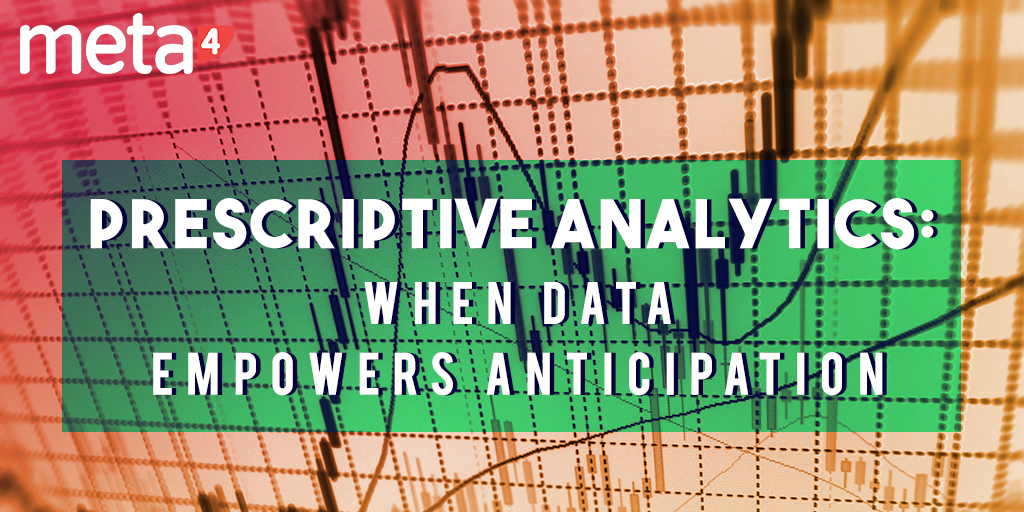By Valérie Dormeau-Ralli, Marketing & Communications Manager for Meta4 France
A mass of raw data has no value if it is not processed. However, by using specific analysis methods such as descriptive, predictive or prescriptive analytics, it is possible to make sense of them to advantage.
Since the Big Data boom, we’ve been hearing a lot about predictive, descriptive or prescriptive analytics. What is the difference between these three concepts?
At the intersection between analytics tapping into existing structured organization data and Big Data tapping into unstructured heterogeneous data, HR Big Data and HR analytics are hot buzzwords today. They have a significant impact in the HR community, particularly on HR decision support issues.
To address such topics which are often complex, the notions of predictive and prescriptive analytics have been developed in step with what is happening in marketing.
When we talk of HR analytics, we must be aware of 3 concepts:
- Descriptive
- Predictive
- Prescriptive
Descriptive analytics is the first stage of data analysis that involves synthesizing historical data to extract useful information or perhaps to prepare for further insights. It provides information on what happened. Next is predictive analytics that explains what can possibly happen based on the information and situation presented. Lastly, prescriptive analytics goes beyond descriptive and predictive analytics to suggest possible actions to undertake. Prescriptive analytics converges into the business analytics field; it looks for the best practical approach for a given situation, in other words, predictive analysis becomes actionable.
How does this work in the HR world in particular?
The basis of a decision is to analyse information and then translate it into decisions and / or intelligent actions to address what the situation requires.
For example, after doing my analysis, I found that the population of young engineers within my company desired short-term mobility, but which has not been satisfactory. Apart from this wish, I also found that this population’s performance assessment to be excellent after three years. These indicators will thus encourage me to reflect on the risk of leaving that this population poses.
So far, HR technology focuses on information processing and retrieval. The system gives me numbers, so I can do my analytical work, but it is up to me, as an HR expert, to explore the possible choices and to decide whether to investigate further or to take action.
The notion of “predictive”, which consists in believing that there is some certainty of what will happen in a given observed situation or that there is a cause and effect link based on information simply correlated to each other, is undoubtedly going a bit too far for now in many situations the HR function encounters. However, it is possible to go from an HR technology which just gives me information, to a system that with the same information, suggests a selective range of relevant actions to me.
If I take my example, the system can suggest I look at the average of employee raises over the last 5 years and to go deeper into this analysis; here we are in the domain of investigation. The system can also suggest I prepare a quick summary (PDF) to send directly to managers to inform or alert them on a scenario they need to examine further, beyond the numbers. This time, we are in the domain of suggested actions.
How does Meta4 apply these concepts?
As a major player in the HR and payroll field, we must be on a constant technological watch to be able to offer ever more innovative solutions. As such, we consider all these facets of analytics to integrate them into our new offerings.
Applying these concepts to payroll, where productivity and quality issues are important, makes it easier for managers. They no longer waste time pulling together the information they need for decision-making. Moreover, these managers benefit from pre-processing, so they can focus their analysis on the issues requiring real expertise and not on straightforward recurring or standard cases.
Technically speaking, how can prescriptive analytics help to make payroll control more reliable?
New features complete our tools, for example, an operational dashboard that supports payroll managers making it easier for them to manage this payroll process.
Let’s look at, for example, indicators such as the number of uncalculated pay slips and the list of employees affected. Previously the payroll manager was notified that the payroll calculation had not been triggered for a certain number of employees. The payroll manager had to investigate and personally decide to resolve the situation. With prescriptive analysis using these same indicators, the information system will propose 2 options:
- To investigate for the manager: offer to find out who entered the employee file for whom the pay slip was not calculated, what this employee’s hire date is (which may in effect be later than the payroll date), and more to understand why this employee was excluded from the payroll calculation.
- To take action: start manual calculation or exclude this employee from the payroll calculation.
We see through these simple examples that beyond digital promises, which are sometimes exaggerated, that there are nevertheless advantages and highly practical, operational benefits that we can expect. analysis guides payroll experts, saves them time, and allows them to direct their energy to where their expertise is really needed. It is a highly practical application that contributes towards the HR function’s productivity. Once again, we can move from words to action through knowledge and in-depth understanding of the activity of HR professionals in this area.






